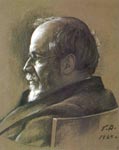Alexandre Benois

Alexandre Benois was an artist in the full sense of the word. He lived, breathed, wrote, created, and celebrated art, both on and off of the ballet stage. As an artist, Benois was not as prolific as a painter for the sake of painting or creating, but rather as a method of ballet set and stage design.
He began his career at the Mariinsky Theatre as a scenic designer, and quickly expanded his role to be at the forefront of ballet set and costume design. His most famous production was Petrushka, in 1911, a production in which he also co-wrote the libretto with composer Igor Stravinsky.
Benois was a founding member of the “World of Art” group, a collection of the artists and art critics of the day, and contributed to the group’s expositions and magazine on a regular basis. As such, Benois was much more than a painter. He was also an art director, ballet librettist, museum curator, art critic, historian, and preservationist. It is perhaps in this vein that he was able to acquire Leonardo da Vinci’s “Madonna,” which he donated to the Hermitage Museum. This painting was later referred to as “Madonna Benois.”
To escape the violence of the Russian Revolution of 1917, Benois devoted his time to the study of art in periods of Russian history. He also became a specialist on ancien-regime French art. In his writings, he stressed individualism and artistic personality, and wanted to combine Western European trends in art with Russian Folk art. Many of his paintings are illustrations of scenic decorations and set designs for ballets, and as such are not as technically accurate as they are emotionally charged and colorful.
Many of his works evince a dreamlike quality, in which the viewer can mentally envision setting foot on stage. Benois produced over 100 writings on topics ranging from art history to his Memoirs, and worked on over 200 ballet productions world wide. He is now considered one of the creators of modern ballet.
